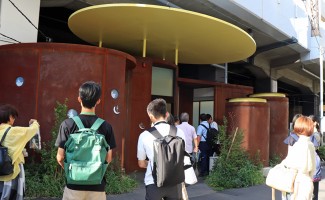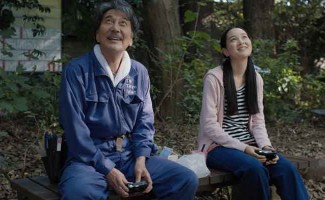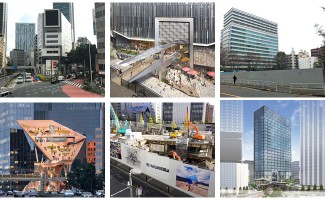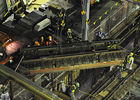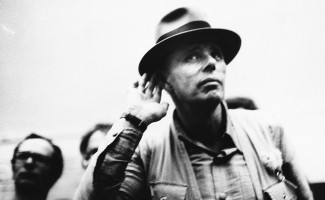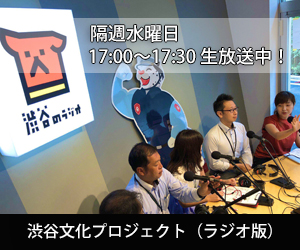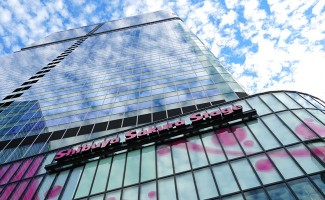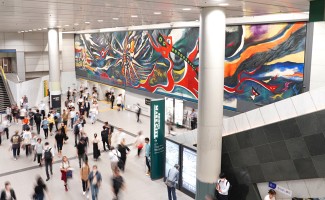Let's chat about Shibuya "He says, She says"
Shinto priest Florian Wiltschko and innovation specialist Chiaki Hayashi get together to chat about the fascination and the future of Shibuya
神職、ウィルチコ・フローリアンと、ロフトワーク代表取締役、林千晶が語る渋谷の魅力と未来。
In order to talk about the future, we also need to unravel history. As a Shinto priest at the Konno Hachimangu Shrine in Shibuya, Austrian Florian Wiltschko is well versed in the history of Shibuya. Chiaki Hayashi, meanwhile, is a representative director at Loftwork and specialises in the creation of innovation through technology and design. We brought them together for a discussion about Shibuya’s past and future.
未来を語ることは、歴史を紐解くことでもある。渋谷の歴史を担うのは、歴史ある金王八幡宮の神職である、オーストリア出身のウィルチコ・フローリアン。一方、渋谷の未来を担うのは、テクノロジーとデザインを用いたイノベーションを画策するロフトワーク代表取締役の林千晶だ。彼ら二人を招き、渋谷の過去と未来について語ってもらった。
Hayashi: The first time I came to Konno Hachimangu Shrine was to attend a TED launch party. I was amazed at how it was located among all these modern buildings, and also how the shrine was able to provide its support for global projects.
H:金王八幡宮には、TEDの打ち上げパーティーがおこなわれた時に初めて来たんですが、こんなビルの間にあることに驚きました。神社がグローバルな企画を支えてくれることにも。
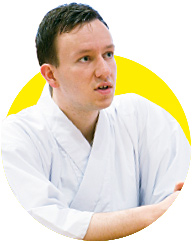
Wiltschko: This is the oldest wooden building in Shibuya Ward, so there is definitely a gap being bridged by holding a modern event like TED here. However, the shrine has always been receptive of new things. A good example of this is Buddhism. When this religion came over from overseas, it was not only well received, but it even became connected to the ancient gods of Japan. Hachiman, the god worshipped at this shrine, was considered to be the strongest god in the whole country, so was therefore chosen to be the bodyguard of Buddha.
W:この建物は、渋谷区で一番古い木造建築で、そんな所で現代的なイベントを開くのはギャップがあると思います。でも神社はもともと、新しいものを受け入れて来たんですよ。その良い例が仏教で、かつて海外から伝わったときには、受け入れるだけじゃなく、日本古来の神様と結びつけたくらいなんです。この神社に祀られている八幡様というのは、全国で一番強い神様として、来賓であるお釈迦様のボディガードに選ばれたんです。
H: Is that right?
H:そうだったんですか?
W: Yes, proof of this is that large Buddhist temples always have a Hachiman Shrine on the side. The shrine closest to the large statue of Buddha in Nara is not actually the Kasuga Grand Shrine, but a Hachiman Shrine. Shrines are not historic ruins. Even to this day, they are still needed and used; they are very much still alive.
W:えぇ、その証拠に大きな寺がある所には必ず、側に八幡神社があるでしょ。奈良の大仏に一番近い神社は実は春日大社ではなく、八幡様なんですよ。神社は、遺跡ではありません。今も必要とされ、使われ、生きているものです。
H: One of the things I am most interested in right now is history. I feel that in order to find out why something is done in a particular land, we need to connect with that land’s history.
H:実は私、いま一番興味があるのが歴史なんですよ。なぜその土地でそれをやるのかっていうのは、土地の歴史と紐づかなければ、多くの場合すぐ消えて行ってしまうなという風に思っていて。
W: In that sense, a shrine is part of the land itself. Long ago, it was believed that each land had its power, and this strength was the god’s power. This is why people would treat the gods with kindness and respect, in exchange for being allowed to use their precious land. And this is why they built the shrines.
W:そういう意味でいうと、神社は土地そのものと言えます。大昔は、土地のひとつひとつに力があると考えられていました。その力が、神様の力だと。天災があったりするのは、神様が怒るからです。だから昔の人は、神様の大切な土地を使わせてもらうかわりに、神様を大切に扱うという契約をしました。そこで神社という神様の家を用意したんです。
H: This is linked to why I decided to base my office in Shibuya. It was a very instinctive thing. As I heard more about its history, I started thinking that maybe this is because the area has its own god.
H:これは私がなぜ渋谷で働くかという話にも通じるんですけど、どこにオフィスを置こうか考えていたときに、この辺に会社があったら気持ちよく仕事ができそうな気がする、というインスピレーションが、渋谷を歩いていたときにあったんです。それは、土地の神様がいるからなのかなという風に、お話を聞いて思いました。
W: There are all sorts of energies at play here. I think the gods in Shibuya are extremely busy [laughs].
W:このあたりはオフィスに加えて、住宅も商業施設もある。あらゆるエネルギーがありますからね。渋谷の神様は、忙しいと思いますよ。(笑)
H: If we take the energy held by the land and include all the things that cannot be articulated, and call it culture, I believe the place that will create the culture of the future will be Shibuya. Our company specialises in finding ways of using design and technology to create new things, and we believe that new things are not born from the same direction that everybody else is looking at.
H:土地が持っているエネルギーや言語化できないものを含めて、文化と呼ぶなら、私は、次の文化をつくっていくのは、渋谷だと思います。うちはデザインとテクノロジーでいかに新しいことができるか、ということに挑戦する会社なんですが、新しいものは、みんなが同じ方向を向いているところでは生まれないんです。
W: Over the years, Shibuya has been developing the foundations of culture. The history of the birth of Shibuya starts from the warriors that came originally from Chichibu, who created their own military movements, receiving the land and name of Shibuya. It was then that they started worshipping Hachiman as their own guardian deity. The paths on the side of the shrine were once linked to Kamakura, a base for the shogunate, becoming a central hub of transportation. In addition, there is now also a hidden river. Until the Meiji period, this was considered a rural area in the suburbs; however, the basic elements that attracted people here were the shrine, the transportation hub and the river.
W:渋谷は大昔から文化の土台を培ってきました。渋谷の誕生の歴史は、秩父から出て来た武士が、武功をたてて渋谷という名前と土地をもらったことが始まりです。そこに、自分の守り神として八幡様を祀った。神社脇の通りは、かつて幕府があった鎌倉に繋がっていて、交通の中心となっていました。あと今は隠れている川があって。明治時代までここは郊外の田舎街でしたが、人が集まる基礎が、神社と、通りと、川にあったんです。
H: In fact, Shibuya has the highest concentration of creative cafés offering services like laser cutting. I was once told by a cultural anthropologist that this was because factories were originally lined up along the river, creating a town that specialised in manufacturing. By unravelling history, we can understand why everybody wants to create things in Shibuya.
H:実は、レーザーカットとか、新しいものづくりができるカフェが一番集積しているのも渋谷なんです。それは、もともと川沿いに工場があって、ものづくりが行われていた街だったからと、文化人類学者の人に言われて。歴史を紐解くと、なぜみんなが渋谷でものをつくりたくなるのかということが分かるんです。
W: By understanding history, we can understand why we are here, as well as what sort of things we should not do.
W:歴史はないがしろにしてはいけないですね。歴史を知ると、なぜここに自分がいるのか、何をしてはいけないかが分かるようになります。
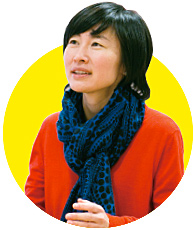
H: If you think about places that keep culture alive from the past as they are linked to the future, Shibuya is this place in Tokyo. Towns that become optimised based on economics and politics have no need to think about history. But when creative people launch themselves towards the rest of the world, they need to learn about the history of their own country. I get the feeling that new things are born from going back further and further into history.
H:文化をいちばん強く残す街、過去から文化を生きたままつなげていく場所と考えると、東京では渋谷だと思います。経済や政治を基礎に効率化した街は、歴史を考える必要はないですよね。一方、演劇家とか音楽家とか、何かを創る人が世界への発進力を持つとなると、自国の歴史を読み解くことが必要になります。新しいものって、どんどん歴史をさかのぼることで生まれるような気がして。
W: I would like Shibuya to be a place that never forgets its roots. It is really important for us to know that, if we were to lose our way, we would always have a place to come back to.
W:これからも渋谷は、ルーツを忘れない街であってほしいです。どんどん時代の変化が速くなっていますが、行く先を見失った場合、帰れる場所がある、というのは大事ですから。
H: I am currently trying to teach the technique of interlocking wood blocks, which is used at the shrine, using a 3D printer. This is a traditional technique handed down through generations of shrine carpenters, whereby buildings are built by interlocking blocks of wood, without the use of any nails. There are now less and less young people who are becoming shrine carpenters. So this is an experiment to encourage others to use once more this Japanese technique of interlocking wood blocks.
H:いま、3Dプリンターを使って、神社に使われている組み木の技術を教えようとしているんです。釘を使わず、木を組み合わせて建物を作る宮大工に伝わる伝統技術ですが、古くなったパーツだけ入れ変えられるという知恵が潜んでいます。宮大工になる若い人が減っている中で、改めて日本が持っている組み木の技術を使ってもらえるよう、技術をデータ化して仕組みを理解してもらったり、なぜそれが生まれたのかを理解してもらう試みです。
W: The best way to learn about culture is to come into contact with it. For example, it is great to hold events like Fashion Week here, to give people an opportunity to visit a historical location.
W:文化を知る一番の方法は、実際に触れてみることです。たとえば日本のルーツである神社に足を踏み入れるきっかけとして、ファッションウィークなどのイベントがあるのは良いことですよね。
H: There are many places in Japan where special experiences can only be had by visiting them in person. Perhaps there are many foreigners who wish to visit Japan precisely because these things cannot be simply packaged up and exported.
H:日本にはその場でしか体験できないものや、やることでしか味わえないものが沢山ありますから。パッケージ化してどこにでも輸出できるようなものじゃないからこそ、日本に行ってみたいという外国人が多いのかもしれません。
W: Absolutely. What you can only experience at a particular location becomes the value of that place.
W:おっしゃる通りだと思います。空気を肌で感じないと体験できないものや、国際化できないものを残しておくことが、観光にもつながると思います。





